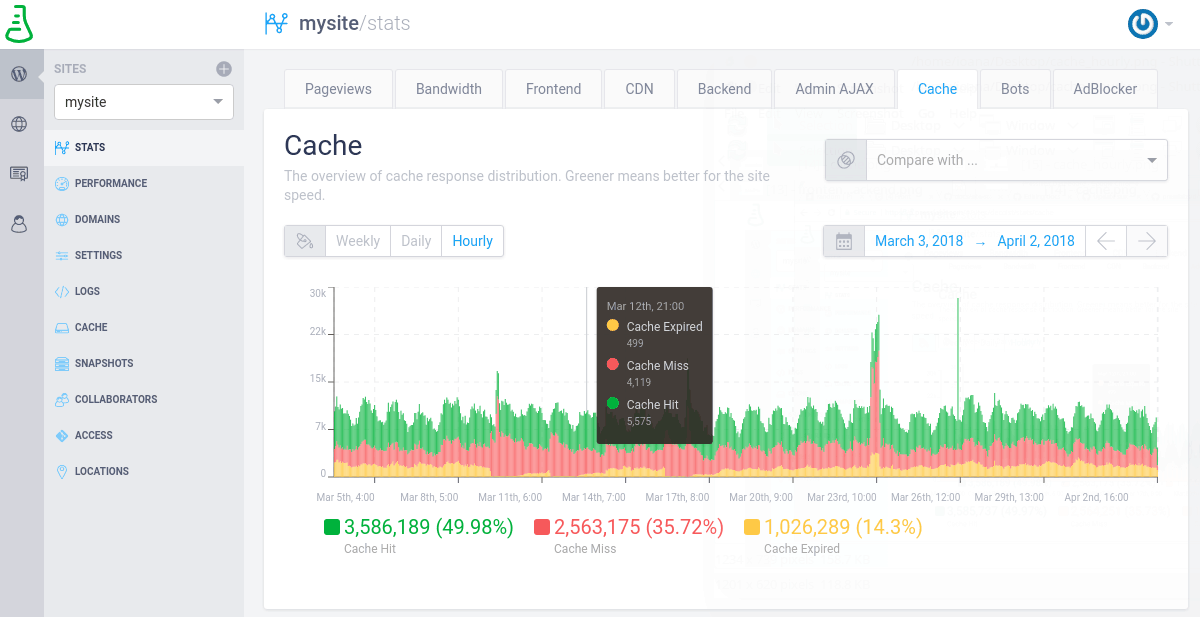Ajax and Cache
The ajax stats help you make sure that such requests don’t flood the backend of your site and the cache response distribution offers you an overview on how many times your site was served from cache, which means faster.
Admin AJAX
Certain plugins and themes use Ajax requests to display real-time information, like the number of shares or comments, or sometimes to load new posts (for infinite scroll sites). Most of the time, these requests flood the Back-end of your site, slowing down the wp-admin area and the site for all logged-in users. In case you recently changed your theme, or just activated a new plugin, and everything seems slower than before, this is a good place to start looking for the source of error.
Thus, this chart shows you the total amount of WordPress Ajax-style calls. The lower they are, the better.
You can disable or enable the display of one of these categories by simply clicking on it.
You have a lot of time filtering possibilities, from the last minute to the last 6 months, along with the possibility of comparing these requests with another metric. All the information in categorized by timezone, based on your computer’s time and location settings.
Cache
This chart represents an overview of the cache response distribution. Find out more information about our cache system here or check our specifications at www.presslabs.com/specifications/ .
You can now see more information about your site’s cache over a selected period of time. To be more specific, we are displaying the hit / miss ratio, which is a unique feature in the WordPress caching ecosystem, and it shows how cacheable your site really is.
In the charts below you can see the cache response distribution over the last 24 hours, both daily and hourly. Greener means better for the site speed.
The three categories (Cache Hit, Cache Missed, Cache Expired) can be enabled or disabled from appearing on the chart with a simple click.
Cache Hit means that your site was served from the cache, Cache Miss means it wasn’t in the cache and the information was retrieved from the Back-end and Cache expired means that the cache for your page has expired , so it was also retrieved from the Back-end.
You also have the possibility of comparing the cache responses with other metrics.
You have a lot of time filtering possibilities, from the last minute to the last 6 months, along with the possibility of comparing these requests with another metric. All the information in categorized by timezone, based on your computer’s time and location settings.
FAQs
Is my site properly cached?
Caching is an incredible technology that allows your site to load extremely fast, by storing a static version of your site’s articles and other pages, instead of generating them over and over again, for each new request. We have implemented our own caching system , specifically tailored for WordPress.
You can easily check if your site is properly cached by inspecting our Cache stats .
Cache Hit means your site is served from cache, Cache Miss means it wasn’t served from the cache and this usually happens for logged-in visitors or pages which are not properly cached, while Cache Expired means there was an old version in the cache, which was served and a cache refresh is triggered for the next request. The Cache Miss percentage usually grows after a cache purge . The greener the chart is the better, as it means your site is served from cache, which is considerably faster.
How do I know if a page is served from cache or not?
In order to check if a page is served from cache or not, you can look at the x-presslabs-stats header. If it has the HIT attribute it means it’s served from the cache:
x-presslabs-stats: HIT; 0.035s; 6 queries; desktop; ttl 86400s; refresh in 53388s
The MISS attribute means it wasn’t in the cache and the information was retrieved from the Back-end, and BYPASS is when the cache is bypassed (usually by logged-in users):
x-presslabs-stats: BYPASS; 0.234s; 29 queries; desktop; ttl 14400s; caching disabled
The page cache is disabled for logged-in visitors. This means that on the development/ staging sites, which are usually password protected, the cache is always disabled. However, in case you disable the requirement to have the dev site password protected, then it will also get served from cache.
What is the impact of errors on the site availability?
As mentioned before, your site is served from cache, so even if your site is temporarily down or encountering problems, the customers will see the functioning, cached version. When logged in however, you are getting the non-cached version of the site, so you will see when it’s down or not working properly.
You can also check the distribution of Front-end responses in the Stats section of the Managed Hosting Dashboard, to see how many requests were a success, a redirect or errors.


